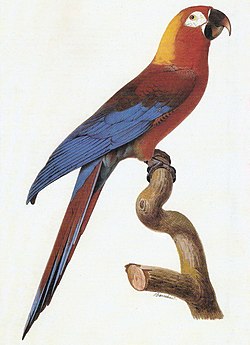Cuban red macaw
| Cuban macaw | |
|---|---|
 |
|
| Painting by Jacques Barraband, ca. 1800 | |
| Scientific classification | |
| Kingdom: | Animalia |
| Phylum: | Chordata |
| Class: | Aves |
| Order: | Psittaciformes |
| Superfamily: | Psittacoidea |
| Family: | Psittacidae |
| Subfamily: | Arinae |
| Tribe: | Arini |
| Genus: | Ara |
| Species: | A. tricolor |
| Binomial name | |
|
Ara tricolor (Bechstein, 1811) |
|
 |
|
| Location of Cuba and Isla de la Juventud | |
| Synonyms | |
|
|
The Cuban macaw or Cuban red macaw (Ara tricolor) was a species of macaw native to the main island of Cuba and the nearby Isla de la Juventud that became extinct in the late 19th century. Its relationship with other macaws in the genus Ara is uncertain, but it may have been closely related to the scarlet macaw, which has some similarities in appearance. It may also have been closely related, or identical, to the hypothetical Jamaican red macaw. No modern skeletons are known, but a few subfossil remains have been found on Cuba.
At about 45–50 centimetres (18–20 in) long, the Cuban macaw was one of the smallest macaws. It had a red, orange, yellow, and white head, and a red, orange, green, brown, and blue body. Little is known of its behaviour, but it is reported to have nested in hollow trees, lived in pairs or families, and fed on seeds and fruits. The species' original distribution on Cuba is unknown, but it may have been restricted to the central and western parts of the island. It was mainly reported from the vast Zapata Swamp, where it inhabited open terrain with scattered trees.
The Cuban macaw was traded and hunted by Amerindians, and by Europeans after their arrival in the 15th century. Many individuals were brought to Europe as cagebirds, and 19 museum skins exist today. It had become rare by the mid-19th century due to pressure from hunting, trade, and habitat destruction. Hurricanes may also have contributed to its demise. The last reliable accounts of the species are from the 1850s on Cuba and 1864 on Isla de la Juventud, but it may have persisted until 1885.
Early explorers of Cuba, such as Christopher Columbus and Diego Álvarez Chanca, mentioned macaws on Cuba in 14th- and 15th-century writings. Cuban macaws were described and illustrated in several early accounts about the island. In 1811, Johann Matthäus Bechstein scientifically named the species Psittacus tricolor. Bechstein's description was based on the bird's entry in François Le Vaillant's 1801 book Histoire Naturelle des Perroquets. Le Vaillant's account was itself partially based on the late 1700s work Planches Enuminées and a specimen in Paris; as it is unknown which specimen this was, the species has no holotype. Jacques Barraband's original watercolour painting which was the basis of the plate in Le Vaillant's book differs from the final illustration in showing bright red lesser wing covert feathers ("shoulder" area), but the significance of this is unclear.
...
Wikipedia

